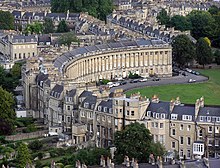Crescent (architecture)


A crescent is an architectural structure where a row of residences, typically terraced houses, are laid out in an arc to form a crescent shape. These are planned developments from end to end, some of which, such as the famous Royal Crescent in Bath and the Marino Crescent in Dublin date back to the 1700s.
Examples
The following are examples of architectural crescents:
- Adelaide Crescent, Hove, England
- Bofills båge, Stockholm, Sweden, by architect Ricardo Bofill
- Buxton Crescent, Buxton, Derbyshire, England
- The Crescent, Limerick, Ireland, double Georgian style crescent
- The Crescent, Scarborough, North Yorkshire, England
- Lansdown Crescent, Bath, England
- Marino Crescent, Dublin, Ireland developed by Charles Ffolliott[1]
- Park Circus, Glasgow, Scotland
- Park Crescent, Brighton, England
- Park Town, Oxford, England
- Plaça Manuel Malagrida, Olot, Catalonia, Spain
- Royal Crescent, Brighton, England
- Somerset Place, Bath, England
- Royal Crescent, Bath, England
- The Crescent, Wisbech, Isle of Ely, England
- Wellington Crescent, Ramsgate, England
- Tontine Crescent, Boston, Massachusetts, USA[2]
References
- ^ "Clontarf Georgian jewel on the market for €1.25m". www.independent.ie. 7 November 2014. Retrieved 3 January 2020.
- ^ Kostof, Spiro (1985). A History of Architecture: Settings and Rituals. New York: Oxford University Press. pp. 619–620. ISBN 0-19-503472-4.
